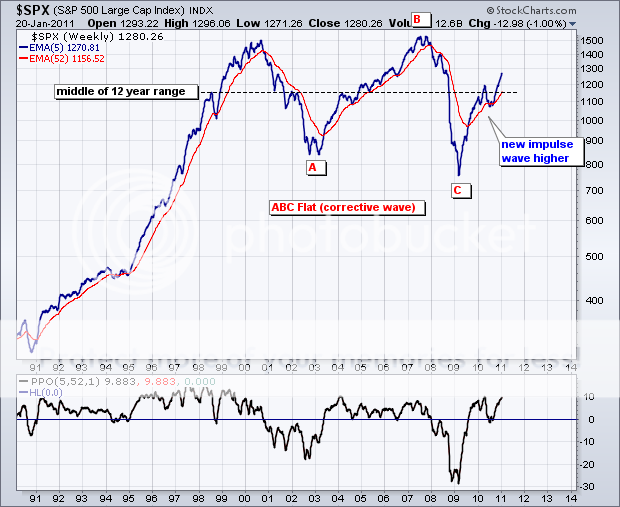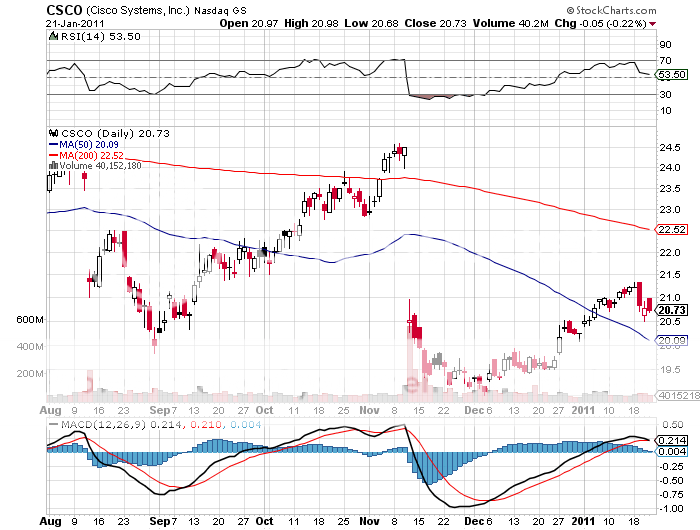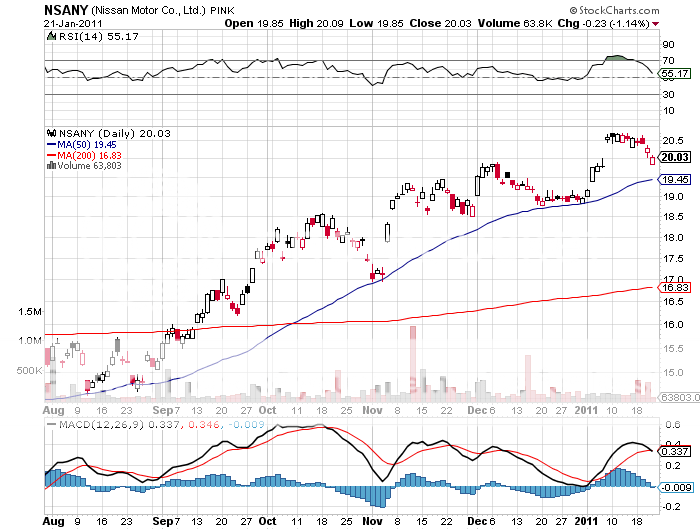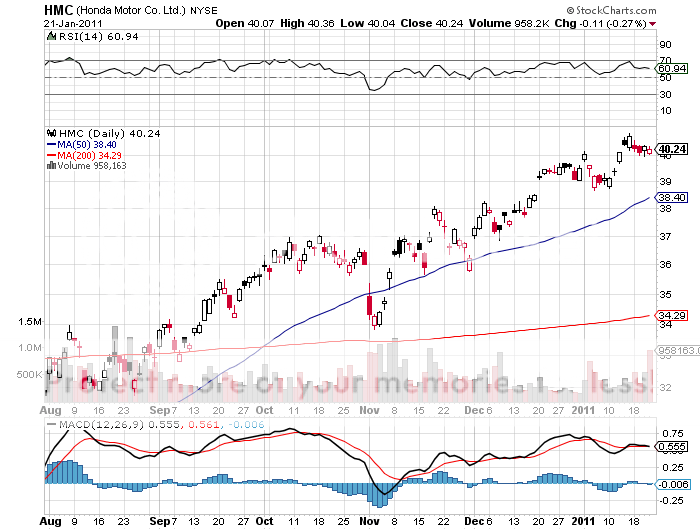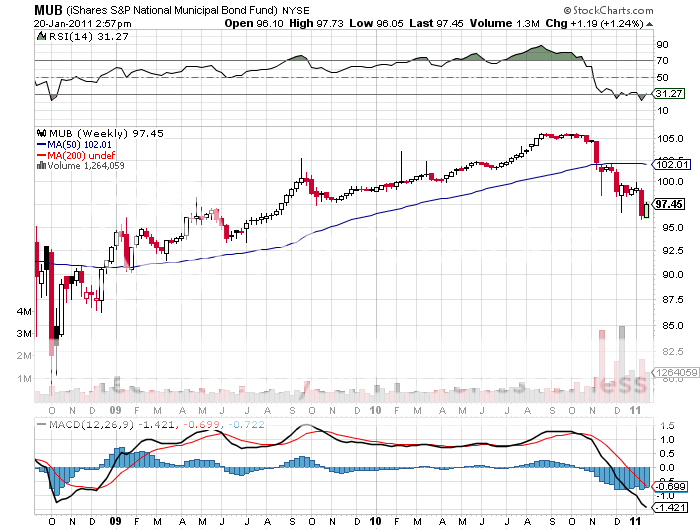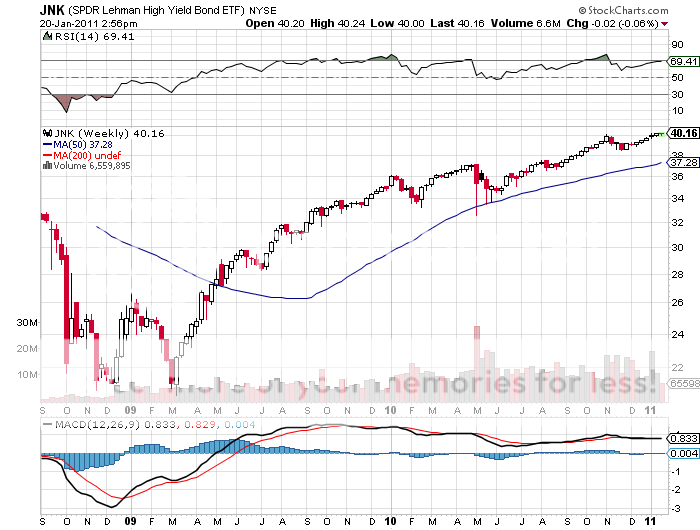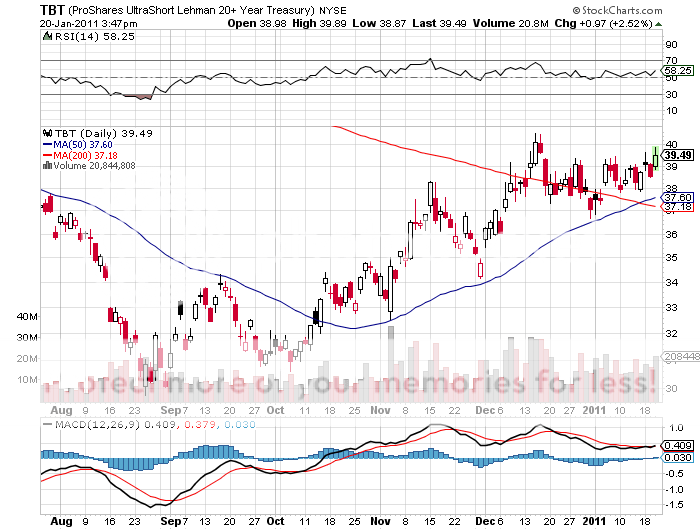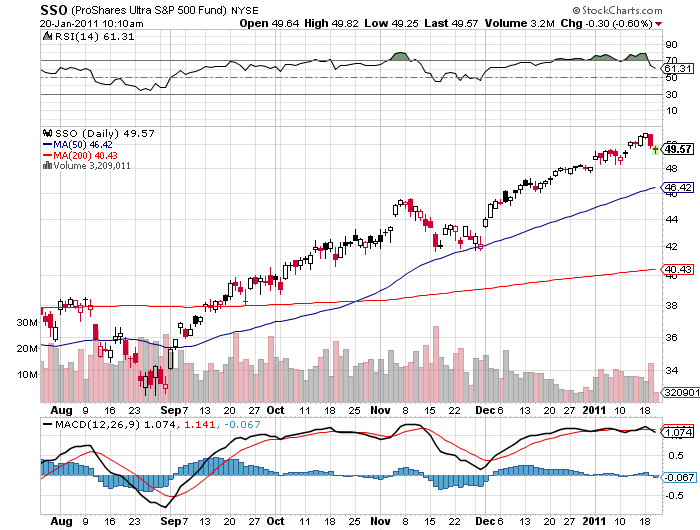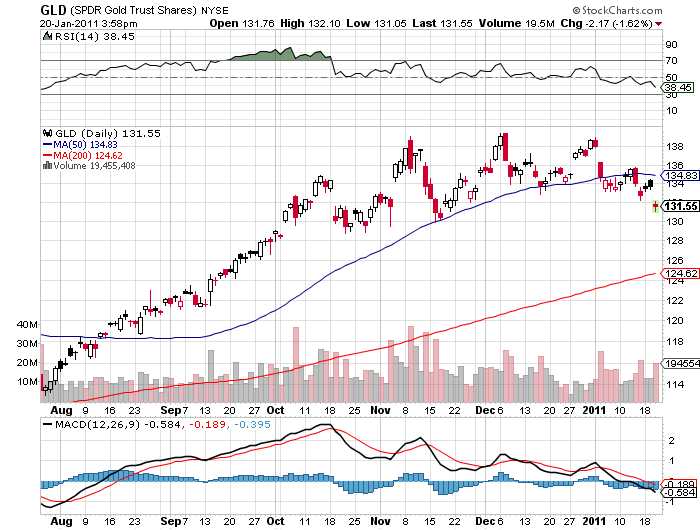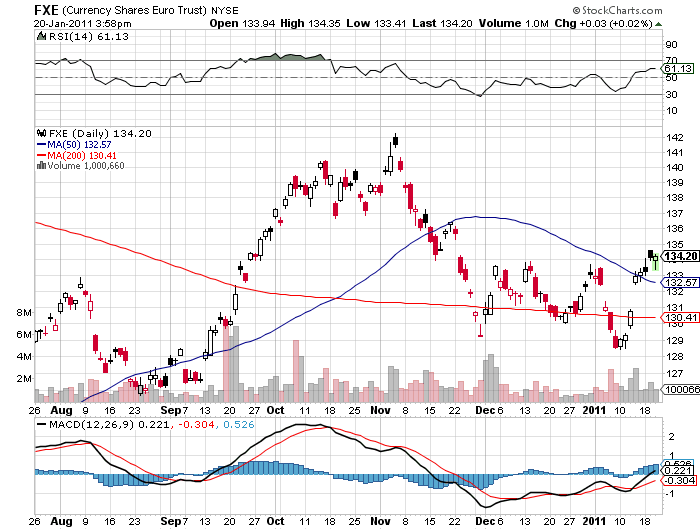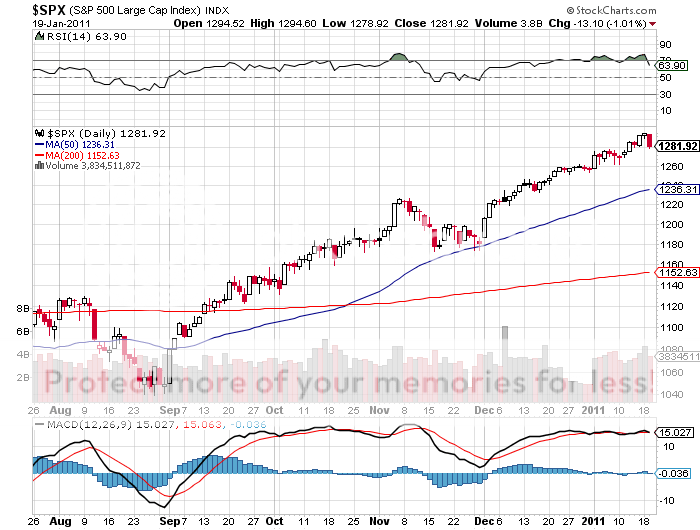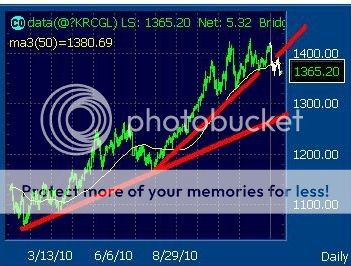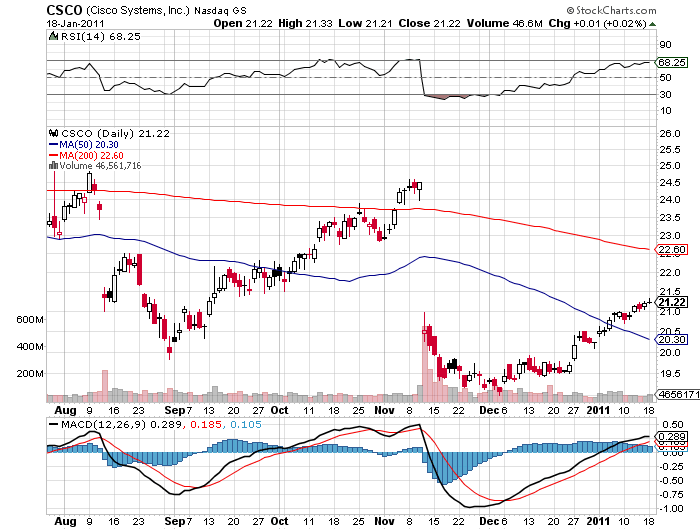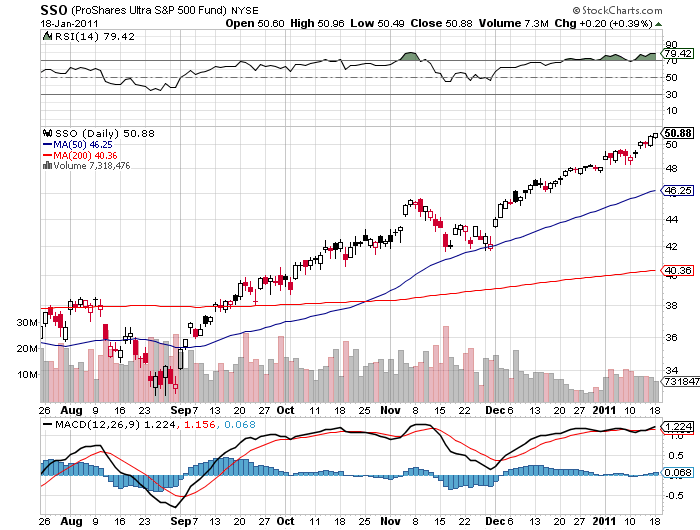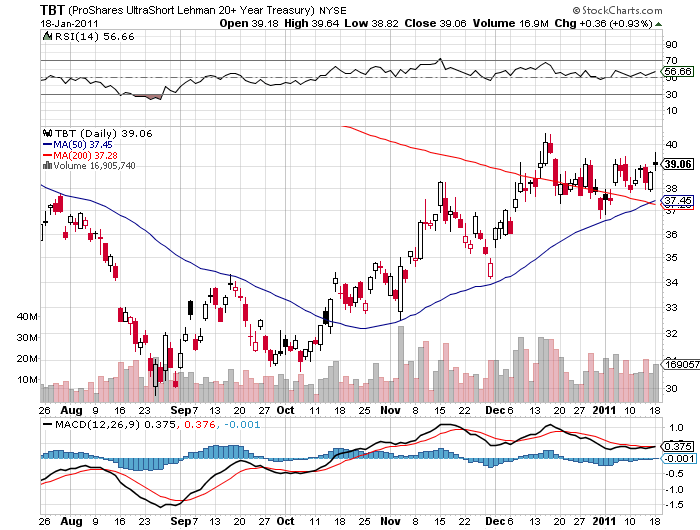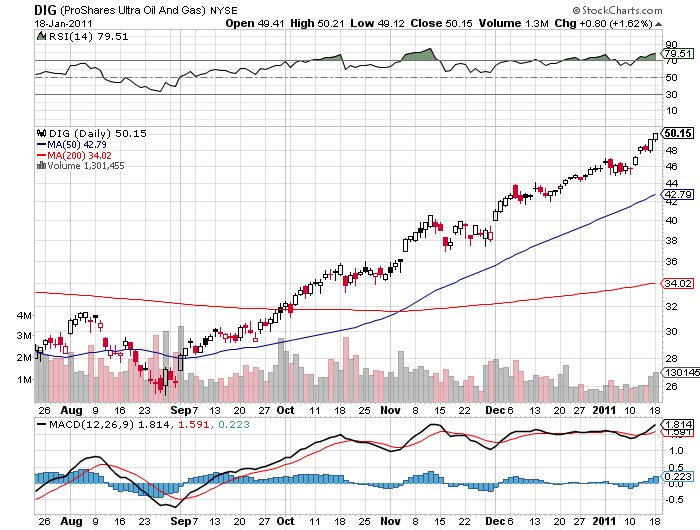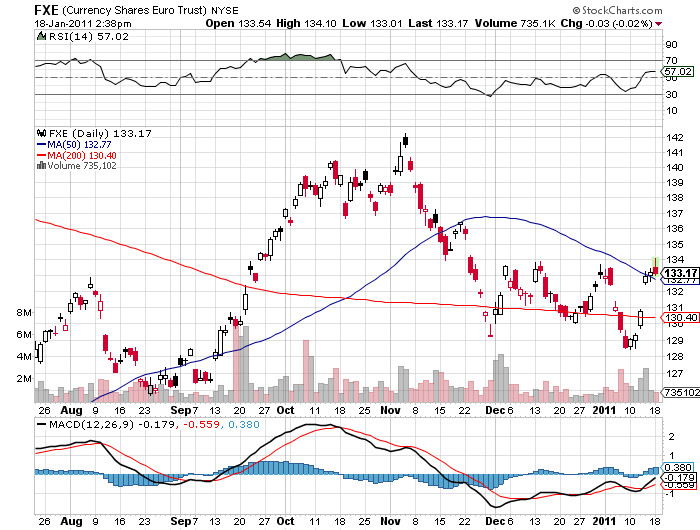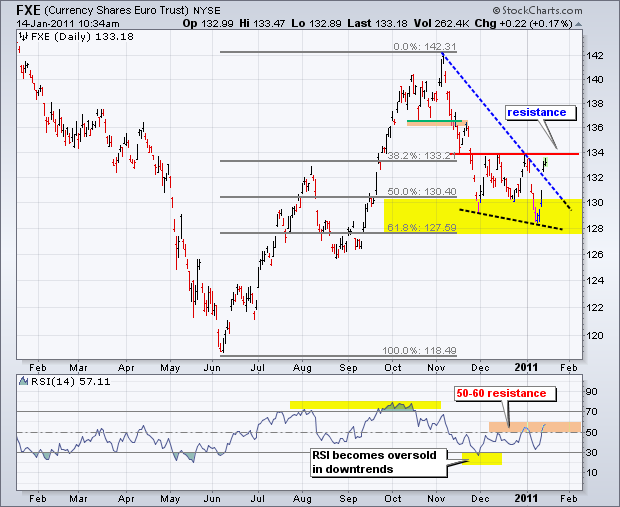
Featured Trades: (DAVID HALE ON THE ECONOMY)
1) The Choppy Road Ahead. Recently, I managed to catch up with my old friend, David Hale of David Hale Global Economics (click here for their site). While swilling a few gin and tonics within the oak paneled walls in the bar at Chicago's exclusive University Club, he outlined his case for the economy for the coming year. Since David is an independent economic advisor to many of the world's top banks and investment firms, I thought his views would be worth passing on.
The economy is currently undergoing a growth spurt, which could deliver an annualized rate of 3% in Q4, 2010. Needless to say, this is hugely bullish for financial markets. Aggressive cost cutting by corporations has taken profitability to record levels. Ben Bernanke's efforts to reflate have also been highly successful.
However, there are storm clouds forming on the horizon. Some $300-$400 billion in financing of state and local governments, the largest portion of the 2008 Obama stimulus package, will soon expire. Given the current make up of congress, it is highly unlikely to be renewed. This could chop some 2.7% off of GDP.
Any truly serious attempt to address our enormous budget deficit will have similar deflationary impacts. The elimination of the tax deductibility of charitable contributions will raise $500 million for the Treasury. Taxing the value of company health insurance benefits will take in another $300 billion. Eliminating the deductibility of state and local taxes conjures up $100 billion in revenues for the feds, while the loss of the home mortgage deduction takes in another $100 billion.
The scary thing about our current predicament is that even if you adopt all of these high contentious proposals, which is unlikely, we will still be left with large annual deficits. That places the sacred cow of defense spending on the altar for sacrifice. Good luck with that. A senior official at Lockheed, the manufacturer of the Hercules C-130 transport plane, once proudly explained to me the firm's strategy of procuring parts in all 50 states, thus creating jobs everywhere and rendering the plane immune to cuts. That's how the Air Force ended up with far more planes that it could ever want or fly. Many other defense programs are similarly dispersed.
The bottom line is that David foresees a coming decade of choppy and volatile GDP growth, which may average out at a lowly 2.5% rate over the long term. That dovetails nicely with my own view that US stocks have not reentered a secular bull market, but are in the process of probing the upper end of a decade long range. Trade, don't own, date, but don't marry. Buy and hold is dead.
Do You See a Trend or a Range?
-
Don't Touch My C-130 Hercules Contract!
Featured Trades: (BIG TECHNOLOGY), (CSCO)
2) Time to Ring the Cash Register on Big Technology. Given the worsening technical picture for the market in general, and technology stocks specifically, I am selling my Cisco Systems (CSCO) March, 2011 $20-$22 call spread at the market. With the stock here at $20.82, I see a middle market for the spread at 98 cents, so I'm using that as my notional exit price. Those 'Macro Millionaires' who came in with me on December 16 when the stock was at a lowly $19.65 are up 66% on the call spread position. Those who shorted the puts with me and covered down 71% three weeks later have made even more money.
Analyze this trade and you'll see what this game is all about. In little more than a month, Cisco Systems stock rose by 5.9%. By risking only 5% of your capital you were able to add 3.31% to the value of your total portfolio.
You found a stock with great fundamentals. You zeroed in on the move with the highest probability of taking place, the next $1 move up, and then leveraged up with a limited risk position that offered much more upside than downside.
This is how you made money on this trade, and will continue to do so on the next one, and the one after that. You could be making your stock picks with a coin toss, and still make money with this strategy. This is how I do it. This is how George Soros and Paul Tudor Jones do it. This is how Morgan Stanley and Goldman Sachs do it. I know because I have been trading with, arguing with, and drinking with these guys for 30 years.
This is not a home run, but is at least a double, and possibly even a triple. Given that in this zero return world, many hedge funds would be happy with an annual 11% return, and would kill for 20%, 3.31% on a single trade is nothing to sneeze at.
I'll probably re enter this trade at a later date with a different set of strikes. On to the next one.
-
Featured Trades: (MY PERSONAL LEADING ECONOMIC INDICATOR)
4) My Personal Leading Economic Indicator.? I just flew over one of my favorite leading economic indicators yesterday. Honda (HMC) and Nissan (NSANY) import millions of cars each year through their Benicia, California facilities, where they are loaded on to hundreds of rail cars for shipment to points inland as far as Chicago.
Two years ago, when the US car market shrank to an annual 8.5 million units, I flew over the site and it was choked with thousands of cars parked bumper to bumper, rusting in the blazing sun, bereft of buyers. Then 'cash for clunkers' hit. The lots were emptied in a matter of weeks, with mile long trains lumbering inland, only stopping to add extra engines to get over the Sierras at Donner Pass. The stock market took off like a rocket, with the auto companies leading.
I flew over the site last weekend, and guess what? The lots are full again. During the most recent quarter, demand for new cars raced up to an annual 12.5 million car rate. Now what? I'll let you draw your own conclusions. Sorry the photo is a little crooked, but it's tough holding a camera in one hand and a plane's stick with the other while flying through the turbulence of the Carquinez Straight. Air traffic control at nearby Travis Air Force base usually has a heart attack when I conduct my research in this way.
-
-
Featured Trades: (THE MUNI BOND MYTH), (MUB), (JNK), (TBT)
2) The Muni Bond Myth. Have I seen This movie before? Two years ago, analysts were predicting default rates as high as 17% for Junk bonds in the wake of the financial meltdown, taking yields on individual issues up to 25%. Liquidity in the market vaporized, and huge volumes of unsold paper overhung the market. To me, this was an engraved invitation to come in and buy the junk bond ETF (JNK) at $18. Since then, the despised ETF has risen to $40, and with the hefty interest income, the total return has been over 160%. What was the actually realized default rate? It came in at less than 0.50%.
Fast forward three years to today (has it been that long?). Bank research analyst Meredith Whitney is predicting that the dire straits of state and local finances will trigger a collapse of the municipal bond market that will resemble the Sack of Rome. She believes that total defaults could reach $100 billion. Since September, the main muni bond ETF (MUB) has plunged from $106 to $97.
I don't buy it for a second. States are looking at debt to GDP ratios of 4% compared to nearly 100% for the federal government, which still maintains its triple 'A' rating. They are miles away from the 130% of GDP that triggered defaults and emerging refinancings by Greece, Portugal, and Ireland.
The default risk of muni paper is being vastly exaggerated. I have looked into several California issues and found them at the absolute top of the seniority scale in the state's obligations. Teachers will starve, police and firemen will go on strike, and there will be rioting in the streets before a single interest payment is missed to bond holders.
How many municipal defaults have we actually seen in the last 20 years? There have only been two that I know of. The nearby City of Vallejo, where policemen earn $140,000 a year, is one of the worst run organizations on the planet. And Orange County got its knickers in a twist betting their entire treasury on a complex derivatives strategy that they clearly didn't understand sold by, guess who, Goldman Sachs. To find municipal defaults in any real numbers you have to go back 80 years to the Great Depression.
My guess is that we will see a rise in muni bond defaults. But it will be from two to only 20, not the hundreds that Whitney is forecasting.?? The market is currently pricing in the triple digit number.
Let me preface my call here that I don't know anything about the muni bond market. It has long been a boring, quiet backwater of the debt markets. At Morgan Stanley, this is where you sent the new recruit with the 'C' average from a second tier school who you had to hire because his dad was a major client. I have spent most of my life working with major offshore institutions and foreign governments for whom the tax advantages of owning munis have no value.
However, I do know how to use a calculator. Decent quality muni bonds now carry 8% yields. If you buy bonds from you local issuer, you can duck the city, state, and federal tax due on equivalent grade corporate paper. That gives you a pre tax yield of 16%, almost as high as the peak we saw in the junk market in 2008. While the market has gotten a little thin, prices from here are going to get huge support from these coupons.
Since the tax advantages of these arcane instruments are highly local, sometimes depending on what neighborhood you live in, I suggest talking to a financial adviser to obtain some tailor made recommendations. There is no trade for me here. I just get irritated when conflicted analysts give bad advice to my readers and laugh all the way to the bank. Thought you should know.
There is one additional instructive thing that is going on in the muni market. The mayhem that we are seeing is but a preview to the real violence that we will see when the US Treasury bond market starts to collapse, possible in a few months. That I can trade, through the leverage short ETF (TBT). This is the real lesson of what is going on in muni land.
-
-
-
This is Not the Muni Bond Market
Featured Trades: (SPX), (SPY), (SSO), (GLD), (CSCO), (DIG), (YCS), (FXE)
3) Ringing the Cash Register for the S&P 500. It's time to ring the cash register on my leveraged long position in the S&P 500 ETF (SSO). I am therefore unloading the position at market here at $49.57, and not bothering to wait for the stop loss that I put out just yesterday. Those who followed me into the (SSO) on December 2 are now up 12.7% in six weeks.
My bet that the big caps would rally into year end, close on their highs, and that New Year reallocations would cause the buying to spill over into January paid off big time. At times I had up to 60% of my portfolio in this one ETF. That's a bet and a half. December turned out to be one of the strongest months for the stock index on record.
We have had such a strong start to the year that my performance, as well as that of other like minded traders, it is ridiculous, if not unbelievable. You can therefore expect many hedge funds to take some chips off the table here, and spend the rest of the year trading against what they banked in the first three weeks of this month.
We are also getting perilously close to the January 25 'sell by' date that technical analysts to the stars, Charles Nenner, warned about in my January 10 interview on Hedge Fund Radio (click here for the link). He is not alone setting off the emergency flares. And no one ever got fired for taking a profit. If the market keeps going up from here, just let your trading buddies pay for the lunch.
With this sale, I am now largely in cash. The few longs I am keeping in Cisco (CSCO) and oil (DIG) are being hedged by shorts in gold (GLD) and the Euro (FXE), which are going gangbusters this morning.
Wake me up when we hit the 5% retracement level.
-
-
-
Time to Ring It for the (SSO)
Featured Trades: (SPX), (BAC), (CSCO),
(DIG), (SSO), (GLD), (TBT), (JJG)
1) Time to Tighten Up Those Stops. Well, the party couldn't go on forever. Yesterday, the S&P 500 took its first 1% hit since November, and the NASDAQ took an even more severe spanking. Like in an Agatha Christie murder mystery, risk has made a sudden reappearance on the scene, after spending much of the show hiding behind the curtains. Since Ben Bernanke launched QE2 and Obama hatched his tax deal with the opposition in mid November, you could count the number of down days in the market on one hand, and the color red had become virtually an extinct species.
What is really interesting about the Wednesday weakness is that it hit virtually every asset class across the board at once. We are not seeing an equity correction, or a commodity correction, but a generalized asset correction of every description. Translate that into a big fat 'RISK OFF' trade. This is why I find hedging across asset classes a useless exercise in a binary world. It just becomes a method for losing money in more interesting and exotic ways.
You could blame Steve Jobs' illness for this state of affairs. In fact, the markets have been over extended for some time. The pros have been expecting this down move with some confidence. This is why I have been steadily scaling back risk in recent days, cutting my (TBT) position in half, bailing on Bank of America (BAC) and grain (JJG) positions, buying back short puts in (BAC) and (CSCO), and cautiously putting out shorts in gold (GLD) and the Euro (FXE).
Given that my 'Macro Millionaire' followers are spectacularly in the money with their seven week portfolios, I am going to exercise some prudence here and tighten up all of my stops considerably on what is left. This is to prevent them from becoming 'Macro Thousandaires'. I am only lowering my stop marginally in the (YCS) to keep someone from stealing my position at the bottom of the market. That way we will still be well ahead of the game if this sell off develops a considerable head of steam. Here are my new stop losses:
(SSO) $48.85
(YCS) $14.85
(CSCO) call spread - $19 in the stock
(TBT) $35
(DIG) $46
(GLD) put spread - $1,450 in gold
(FXE) put spread - $1.40 in the euro
To paraphrase Winston Churchill, this is not the end, nor the beginning of the end. But it is the end of the beginning. If you want to buy dips, you have to sell the rallies.
-
Winnie
Featured Trades: (GLD)
2) Look What I'm Seeing in Gold. Call this a 'rolling top' or a 'head and shoulders top', but it is a top nonetheless, which is making my bear put spread of the gold ETF (GLD) look smarter by the day. If our current sell off is truly a binary 'RISK OFF' development rather than a reshuffling of the deck among asset classes, then the barbarous relic should swan dive along with everything else. This then provides my bearish gold position the additional merit that it will tend to hedge my remaining longs in other asset classes during any continuing weakness. Just thought you'd like to know.
-
Is a Short Gold Position a Hedge for everything else?
Featured Trades: (IBM), (AAPL), (CSCO), (SSO),
(TBT), (GLD), (DIG)
1) Time for a Victory Lap. I'm sorry I'm late with the letter today, but I am out of breath, having run victory laps all morning. IBM (IBM) reports blowout earnings, and Apple (AAPL) absolutely knocked the cover off the ball. It kind of makes my Cisco Systems (CSCO) options position look pretty good, which has already doubled from my cost. It looks like my friend, technical analyst to the stars, Charles Nenner, owes me a case of 80 proof Bols.
It also looks my hefty long in the (SSO) look sweet, the 200% leveraged long in the S&P 500. Huge earnings surprises in global multinational technology stocks ought to give some oomph to the dollar, and provide some juice for my new short in the Euro. I guess this all will make Treasury bonds suck more, much to the benefit of my (TBT) long, the leveraged bet that these debt instruments will fall.
A stronger than expected economy certainly make the argument for stronger oil prices even more compelling, which is why the (DIG) hit a new two year high today. Investors' newfound love with paper assets is preventing gold from rallying, despite an $80 plunge in the barbarous relic in just two weeks, which is why I am short the barbarous relic.
Only the Japanese yen is out there mooning me big time, reminding me to be humble. It is grinding around my cost, instead of dropping like a rock, like it should. But I'll take a push over a loss any day.
All of this explains why my new 'Macro Millionaire' service followers are up 25% in their first 7 weeks of trading, bagging 11.5% in January alone.
Please allow this old fart his delusions of grandeur. Was it something I said?
-
-
-
-
Check Out My Yen Position
Featured Trades: (FXE)
2) Time to Short the Garlic Eaters. The garlic eaters don't want to repay their debts, and the beer drinkers don't want to lend them any more money. That pretty much sums up the financial tensions that exist within Europe right now. The PIIGS countries of Portugal, Ireland, Italy, Greece's, and Spain are lurching from one emergency financing to the next. Never mind that much of that money was borrowed to buy Mercedes, BMW's and Volkswagens, which enriched Germany's economy mightily.
This is one of many reasons why I think the Euro will continue to fall against the dollar, possibly to as low as the mid $1.10's some time this year. The US is growing, and Europe is not. American interest rates are rising, while Europe's are not. This always attracts capital to flow out of the low yielding currency and into the high yielding one, which is creating a rising tide of buyers of greenbacks and sellers of Euro's.
The Euro has just enjoyed a five cent rally against Uncle Buck. Last week, the Spanish and Portuguese bond issues came off better than expected. Germany's Chancellor Angela Merkel hinted they might bend a little on terms. The UK's CPI came in hot. Then China and Japan came in and said they would happily take down a chunk of the high yielding debt. With ten year Japanese Government Bonds yielding a paltry 1.23%, can you blame them?
That is the logic behind my recommendation to buy the June, 2011 $132-$129 put spread on the (FXE), the main Euro ETF. This involves buying the June $132 puts and selling short an equal number of June $129 puts for a net cost of $1.18. The recent sigh of relief has taken the Euro up to the top of a two month trading range at $1.34. So I am going to take the gift and put out a small short here. A $100,000 portfolio should put 5% of its capital into this trade, which works out to 42 contracts on each side.
The position reaches its maximum profitability if the Euro closes at or below $1.29 on June 17, 2011. That would pump the value of the spread from $1.18 to $3.00 for a gain of $1.82, or 182%. The June expiration gives this plenty of time to work. Then will bind out if the garlic eaters, and the 'Macro Millionaires' who strapped this baby on, have the last laugh.
-
-
Would You Want to Owe Her Money?
'President Obama needs to explain that while these cuts will be painful, there is no way to solve our problems without shared sacrifice,' said Christina Romer, Obama's former Chairperson of the council of Economic Advisors.

